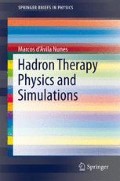The online version of the original book can be found at http://dx.doi.org/10.1007/978-1-4614-8899-6
You have full access to this open access chapter, Download chapter PDF
Keywords
- Frankfurt Institute For Advanced Studies (FIAS)
- Monte Carlo Treatment Planning
- Hadron Therapy
- Nuclear Fragmentation Reactions
- Linear Beam Elements
These keywords were added by machine and not by the authors. This process is experimental and the keywords may be updated as the learning algorithm improves.
The publisher regrets that some figures and text sections were not fully cited in the original publication. The following figures are in whole or in part copyright of Lucas Burigo, and reproduced with permission:
Figure 4.1
Figure 4.2
Figure 4.3
Figure 4.4
Figure 4.5
Figure 4.6
Figure 4.7
Figure 4.8
Figure 4.9
Figure 4.10
Figure 4.11
Figure 4.12
Figure 4.13
Figure 4.14
Figure 4.15
Figure 4.16
The following sections of text utilized the work of Lucas Burigo as a reference:
Section 4.4:
Thus, important information can be obtained regarding cancer therapy using heavy ions, especially when coupled with Monte Carlo simulations. Monte Carlo codes can be used to:
-
Calculate the dose distribution libraries at various levels of beam energy, as entries in planning systems for analytical treatment.
-
Verify the results of the planning systems for analytical treatment, taking into account biological effects.
-
Calculate doses outside the field.
The FLUKA MC code is used at the Heidelberg Ion Therapy Centre (HIT) for these purposes. Monte Carlo simulation is a slow process (h) relative to the planning system used for analytical treatments (min).
Section 4.5:
The search tool MCHIT was developed in the Frankfurt Institute for Advanced Studies (FIAS) in Germany to study ion transport through a medium similar to tissue, in the energy range used for cancer therapy with heavy ions (Fig. 4.6). The model is based on the application Geant4 software, which is used as a platform for the simulation of the passage of particles through matter. Geant4 is applied to the relevant experimental data in particle therapy. It works with phantoms and linear beam elements, but the same physical models can be used for Monte Carlo treatment planning.
In the physical processes of particle transport, the calculations take into account the following:
-
1.
The loss of energy by ionization.
-
2.
Multiple Coulomb scattering.
-
3.
Nuclear fragmentation reactions.
As mentioned, regarding the energy loss by ionization, -dE/dx corresponds to 1/β2 and equals 1/E (continuous drop: formulas, tables or approximations). With MCS formulas and approximations are used. Nuclear fragmentation consists of simple events, and many secondary particles of several species are produced at large angles (this process is difficult to describe using a formula; Fig. 4.8).
Section 4.7.1
4.7.1 Conclusions
-
The methods that are used to model detectors in experiments regarding nuclear and particle physics are also successful in simulating particle therapy (hadron therapy).
-
The MCHIT model describes the transport of carbon nuclei with therapeutic energy into water (water phantom).
-
The model describes the production of secondary nuclei from the fragmentation caused by the carbon beam.
-
In general, microdosimetry spectra for 12C beams are described by MCHIT.
-
With this model the contribution to the dose from protons and neutrons outside the treatment field can be estimated.
-
The MCHIT model can be extended for dose calculations around the ion track, on a scale of a few nm.
We expand a number of entries from the Appendix for further accuracy and information:
What is the intensity-controlled raster scan method (ICRM)?
Answer: ICRM involves tumor detection in 3D so that the correct dose of carbon ions can be delivered. Increasing the energy of the carbon ions in the beam increases the depth of tissue penetration. By using horizontal and vertical magnetic fields, the ion beam can be displaced to the left or right. Thus, the tumor can be scanned in 3D, pixel by pixel.
What are hadrons?
Answer: in the narrow definition in particle physics these are strictly the subatomic particles made from quarks, anti-quarks and gluons (baryons and mesons) subject to the strong interaction. In medical physics jargon, the definition is broadened to include all highly interactive particles which are used in “hadron therapy”, ranging from protons and neutrons to pions and heavy ions (α, C and Ne).
What is a phantom?
Answer: a specially designed artificial system which represents a reasonably accurate model of a biological system under investigation. It is used in medical imaging to evaluate the performance of an imaging device. The water phantom shown in Fig. 4.3 is a physical tissue model which mimics stochastic energy deposition in a cell nucleus.
What is MCHITand what is Geant4?
Answer: MCHIT stands for Monte Carlo model for Heavy-Ion Therapy. It is a software application based on the Geant4 open-source library of computational toolscreated by the international high-energy physics community. GEANT stands for GEometryANd Tracking.
Author information
Authors and Affiliations
Rights and permissions
Copyright information
© 2014 Marcos d’Ávila Nunes
About this chapter
Cite this chapter
Nunes, M.d. (2014). ERRATUM TO. In: Hadron Therapy Physics and Simulations. SpringerBriefs in Physics. Springer, New York, NY. https://doi.org/10.1007/978-1-4614-8899-6_6
Download citation
DOI: https://doi.org/10.1007/978-1-4614-8899-6_6
Publisher Name: Springer, New York, NY
Print ISBN: 978-1-4614-8898-9
Online ISBN: 978-1-4614-8899-6
eBook Packages: Physics and AstronomyPhysics and Astronomy (R0)

